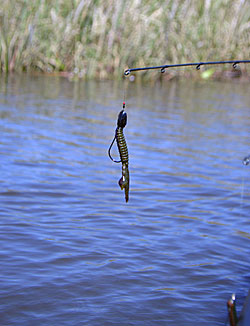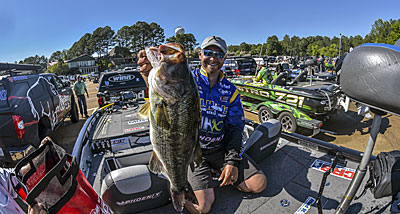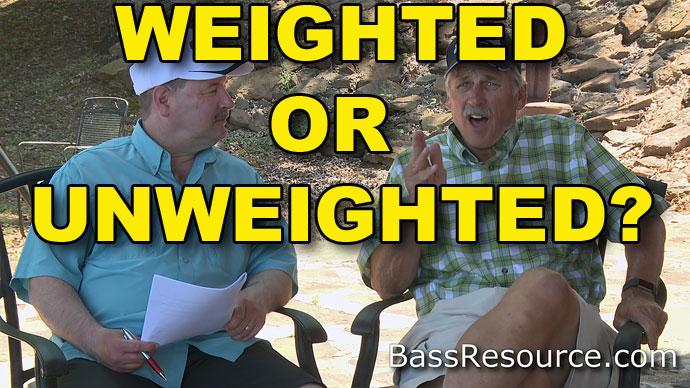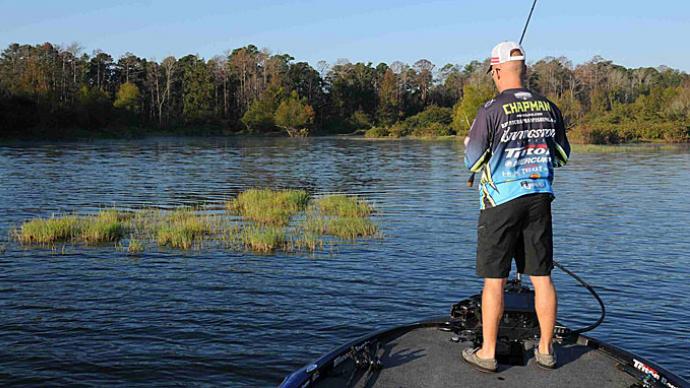
As water temperatures warm in summer, anglers turn to Texas-rigged soft-plastic lures in many situations, from plying heavy cover along the bank to probing aquatic vegetation in the mid-depths to looking for schoolies along deep river channel ledges. Only the bass know what the rig imitates. All bass anglers care about is that it catches lots of fish.
A Texas rig is a simple setup, but there are better ways to build this mousetrap. Bassmaster Elite Series anglers Brandon Lester and Bradley Roy have done just that. Each chooses specific components — from reel to lure — that work together to ensure they have the best shot at catching every bass that bites. Here's how they build the ultimate Texas rig.
Reel
There's only one reel choice for Roy, the youngest angler to qualify for the Elite Series and finished seventh in his first Bassmaster Classic, the 2017 edition on Texas' Lake Conroe. It has to be a baitcasting reel with a gear ratio of at least 7:1. The reel isn't used to work the lure like a crankbait. Instead, Texas rigs are moved with the rod, and the reel collects slack line. Many strikes occur on the fall, so you need a speedy reel to catch up and set the hook.
Choose a low-profile reel. You'll be palming it to have a better feel for bites, ranging from sharp taps to light mushy pressure. The less you have to hold, the more comfortable you'll be.
Rod

Roy makes several different presentations when he fishes a Texas-rigged soft-plastic lure, so he wants a light and sensitive rod. The rod measures 7 feet 6 inches and has heavy power and fast action. It lets him pitch to shoreline targets or bomb long casts to a brush pile on a deep point. Not having to drop one rod to pick up another saves him time under the always-ticking tournament clock.
A longer rod is easier to cast than a shorter one and helps you drive the hook home. It also provides more of a pendulum effect when pitching and flipping in tight quarters, increasing accuracy.
You want lots of backbone to drive the hook through the soft-plastic lure and into the bass. Big fish can engulf the whole rig, meaning you'll have to move the hook inside one's mouth before it makes contact with the bass. A fast action will help you feel strikes, which often come on the fall.
Line
Lester, who has qualified for two Classics and won more than $250,000 in 53 B.A.S.S. tournaments, said he only uses one line to string together a Texas rig: fluorocarbon. Cover density will dictate if he uses 15- or 17-pound test.
The reasons are simple. Its light refraction rate is closer to that of water than monofilament or braid, making it less visible to bass. He said it's tough, so there's less chance of it breaking. It's sensitive, so you feel even the timidest bass inhale your Texas rig. And it has almost zero stretch, so you can drive the hook home, even at the end of a long cast.
Weight
The weight's job is to drag your Texas-rigged lure down to where the bass swim. It pays to fish as light of a weight as possible. In shallow water — less than 3 feet — you can get away with 1/16 or 1/8 ounce. You'll want 3/8 or even 1/2 ounce of weight on a deep ledge to cut through 15 or 20 feet of water.
Extremely heavy cover, especially aquatic grass, demands a heavier weight regardless of depth. Flippers on Florida's grass-filled Lake Okeechobee, for example, routinely fish with 1- to 2-ounce weights. They allow them to crash through thick mats of hyacinths and stands of reeds to reach bass.
One more consideration when selecting the weight size for your ultimate Texas rig. You want one that is heavy enough to activate the action that's built into your soft-plastic lure. Ribbon-tail worms, for example, need more weight than those with a straight tail to swim.
There is no question of the weight's shape. Bullet weights fit against a soft-plastic lure, creating a streamlined package that can efficiently work its way into — and, more importantly, back out of — cover. You'll want one made of tungsten, a hard material denser than traditional lead. "That has elevated the Texas rig game to another level," Roy said. Tungsten weights are smaller than lead ones of the same weight. That reduces snags, he said. And its density lets you feel the bottom better. Rocks, for example, feel like sharp taps.
Avoid locking down your weight with a bobber stop, rubber peg, or toothpick. Letting it slide gives your lure more action and can cause bass to hold onto your lure longer. The only exception is in heavy cover. You'll need to peg to ensure your lure follows the weight to the bottom instead of getting caught in the cover part way down. But don't peg the weight tight against the lure. Keep about a ½ inch of slack between the two. That will give your lure more action.
Hook
The line is the most critical link between you and the bass: That well-worn saying is only valid if the hook holds. Lester and Roy have spent much time making sure that happens.

Lester said his hook choice is vital to the overall success of his Texas rig. His favorite is one he helped Mustad design about a year ago. The Grip Pin Big Bite 2X Hook features a longer shank, which puts its point farther back in the lure. Just behind the sealed eye, which keeps the thinner diameter line from slipping out, is an offset bend and an oversized keeper barb, which keep the soft-plastic lure from sliding down the hook.
Lester said the hook features a round bend, his most important feature. Roy agrees: "Hooks are where people get misguided sometimes." Many anglers favor an extra-wide gap hook, believing it will handle the soft-plastic lure and still have enough gap to hook a bass. But in reality, Lester said, they would have a better chance of hooking a bass with a round-bend hook.
When you look at an extra-wide gap hook, Roy said you'll notice the point is in the same plane as the line tie. So, for the point to bite, the bass has to grab the lure ideally between the two, or the hook has to flex outward enough for the point to clear the line tie. There's little chance of either happening. With the round bend, the point is well above the line tie. "It has a great chance of putting a point in the fish's mouth," Roy said.
Use as big of a hook as your soft-plastic lure will hold. If you are using a 6-inch worm, for example, go with a 3/0 hook. Worms 7 or 8 inches long will need a 5/0, and 10-inch ones should get a 6/0.
Lure
Picking the best soft-plastic lure for a Texas rig is personal. If you go with historical precedent, it's a simple choice — a worm. But if a creature bait has won you several tournaments in a row or caught your biggest bass, that's what you're threading on your hook. In short, the perfect lure is the one you have the most confidence in.
Lester's favorite is a straight-tail worm such as Zoom's Trick Worm. "Not a lot of people throw that," he said. But he is also not afraid to throw 10- to 11-inch curly tail worms if conditions make bass aggressive.
Roy likes to use a giant worm, too. But Texas rigs aren't limited to worms. You can throw lizards, stick worms, and even craw worms, which have fallen out of favor among most anglers.
But regardless of which one you choose, there are a few things to remember. First, rig your lure straight. Line twists can be frustrating, and a miss-rigged lure is a quick way to lose patience. Instead of steadily swimming through the water, it begins to spin, and with no swivel on the line, the line twists. That results in more frequent backlashes and tangles around the rod's tip and line guides, which means you must stop fishing to fix them.
Luckily, soft plastic lures, except hand-poured ones, come with mold lines, making rigging easy. Insert the hook about 3/8 inch into the center of the end of the lure, then push it out along one of the lines, pulling the hook through until the knot is inside the plastic. Rotate the hook 180 degrees, and use your thumb to mark the bend when you lay the hook alongside the lure. Creating a slight kink in the lure, push the point into the worm along the same mold line where your thumb is.
You'll have two choices when you push the point through the other side of the lure. The first is simply pushing it through and then pulling the point back into the plastic. That creates a channel for the hook to travel through when you set it, and it's the most weedless option. The second involves pushing the hook through, laying it against the lure, and "skin hooking" the point in the plastic. It's best when the cover is sparse or the bass aren't aggressive.




